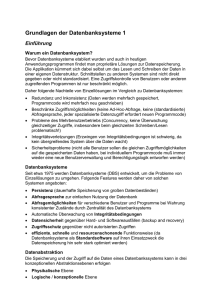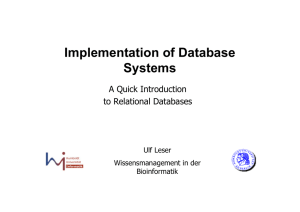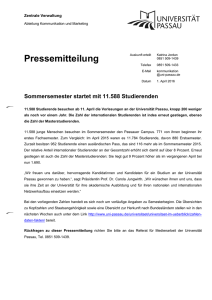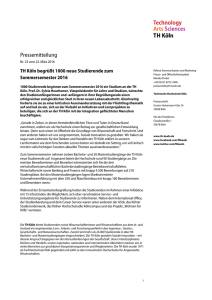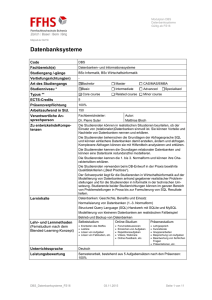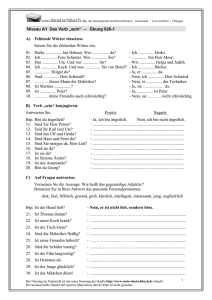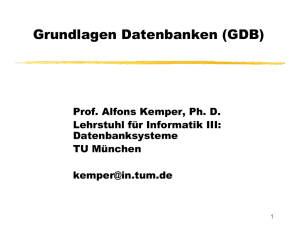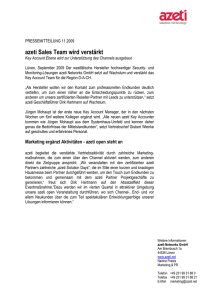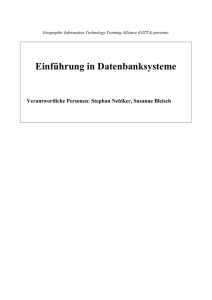Architektur von Datenbanksystemen und Übersicht über die
Werbung
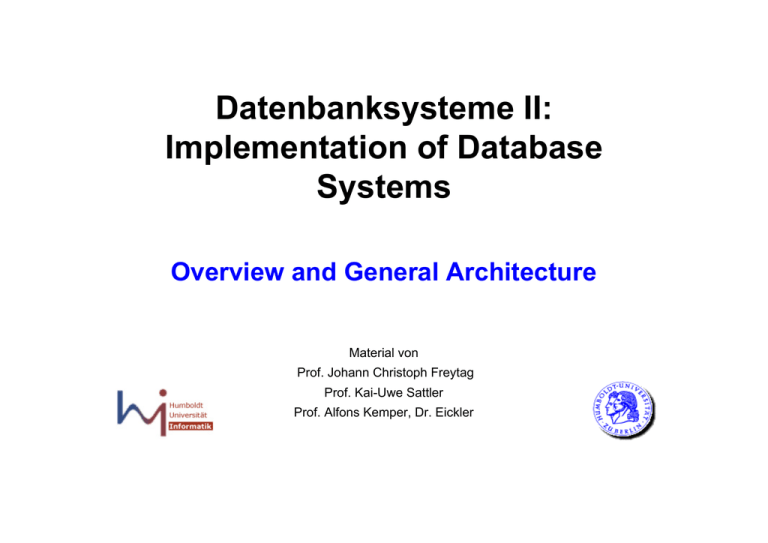
Datenbanksysteme II:
Implementation of Database
Systems
Overview and General Architecture
Material von
Prof. Johann Christoph Freytag
Prof. Kai-Uwe Sattler
Prof. Alfons Kemper, Dr. Eickler
Speicherhierarchie
Register
(L1/L2/L3)
Cache
Hauptspeicher
Plattenspeicher
Archivspeicher
Ulf Leser: Datenbanksysteme II, Sommersemester 2005
2
Überblick: Speicherhierarchie
Register
Cache
Hauptspeicher
1 – 8 Byte
Compiler
8 – 128 Byte
Cache-Controller
4 – 64 KB
Betriebssystem
Plattenspeicher
Archivspeicher
Ulf Leser: Datenbanksysteme II, Sommersemester 2005
Benutzer /
Roboter
3
Überblick: Speicherhierarchie
1-10ns
Register
10-100ns
Cache
60-300ns
Hauptspeicher
10-20 ms
Plattenspeicher
Zugriffslücke
105
sec - min
Archivspeicher
Ulf Leser: Datenbanksysteme II, Sommersemester 2005
4
Ebenen
• Konzeptionelle Ebene
– Relationen, Tuple
– Attributwerte
• Variable Länge und Typ
• Logische Ebene
– Dateien
– Sätze
– Felder
• Physikalische Ebene
– Laufwerke
– Blöcke
– Zylinder und Sektoren
Ulf Leser: Datenbanksysteme II, Sommersemester 2005
5
5 Schichten Architektur
Mengenorientierter Zugriff
Datenmodellebene
Satzorientierter Zugriff
Logischer Zugriff
Interne Satzschnittstelle
Speicherstrukturen
Systempufferschnittstelle
Pufferverwaltung
Dateischnittstelle
Betriebssystem
Anfrageübersetzung,
Zugriffspfadwahl, Zugriffskontrolle,
Integritätskontrolle
Sortierung, Transaktionsverwaltung,
Cursorverwaltung, Data Dictionary
Physical Record Manager, Index
Manager, Sperrverwaltung, Log /
Recovery
Seitenverwatung, Puffermanagement,
Caching
Externspeicherverwaltung
Geräteschnittstelle
Ulf Leser: Datenbanksysteme II, Sommersemester 2005
6
Objekte und Operationen
Mengenorientierter Zugriff
Datenmodellebene
Satzorientierter Zugriff
Logischer Zugriff
Interne Satzschnittstelle
Speicherstrukturen
SQL: select ... from ... Where
Grant access to ...
Create index on ...
OPEN – FETCH – CLOSE (Tab o. Ind)
STORE Record
STORE: RECORD auf Seiten
Aktualisierung aller Zugriffspfade,
Implementierung B*-Baum
Systempufferschnittstelle
Pufferverwaltung
READ page
WRITE page
Dateischnittstelle
Betriebssystem
Disc driver
MOVE head ...
Geräteschnittstelle
Ulf Leser: Datenbanksysteme II, Sommersemester 2005
7
Schnittstellen
• Mengenorientierte Schnittstelle
– Zugriff auf Tupelmengen über deklarative Sprache
– SELECT ... FROM ... WHERE ...
– Überwachung Datenintegrität und Autorisierung
• Satzorientierte Schnittstelle
– Zugriff auf typisierte Tupel
– Zugriff auf logischer Zugriffspfade (Indexe, Scans)
– Verwaltung Partitionen
• Interne Satzschnittstelle
–
–
–
–
Zugriff auf uniforme, ungetypte Tupel
Sperrverwaltung
Verwaltung Abbildung Tupel (alle logischen Objekte) auf Seiten
Implementierung und Aktualisierung der Zugriffspfade
Ulf Leser: Datenbanksysteme II, Sommersemester 2005
8
Schnittstellen
• Systempufferschnittstelle
– Zugriff auf Blöcke in virtuellem Adressraum
– Abbildung virtuelle auf physikalische Blockadressen
– Sperren und Freigeben von Blöcken
• Dateischnittstelle
– Zugriff auf physikalische Blöcke
– Verwaltung Block zu Segmenten, Tablespaces, Dateien
– Software-RAID
• Geräteschnittstelle
–
–
–
–
Zugriff auf Daten der Festplatte
Adressierung der Platten – Platte, Spur, Sektor
Cache des Controllers, Prefetching
Hardware Raid
Ulf Leser: Datenbanksysteme II, Sommersemester 2005
9
5-Schichten Architekur
• Idealisierte Darstellung
– Muss nicht so implementiert werden
– Vielfältige Querverbindungen durch Synchronisierung, Recovery, ...
• Schichten können zusammengefasst werden
– Z.B. Schicht satzorientierte und interne Satzschnittstelle
• Schichten müssen oftmals durch mehrere andere Schichten
„hindurch greifen“ können
– Caching benötigt für Prefetching Informationen über aktuelle
Workload, nicht nur über das aktuelle Tupel
• Von Schicht 4 zu Schicht 1/2
• Eventuell sogar von Schicht 5 zu Schicht 1/2
– Optimierer benötigt Informationen über physische Verteilung von
Blöcken auf Disc
• Von Schicht 1 zu Schicht 4/5
– Verletzung des „Information Hiding“ Prinzips
Ulf Leser: Datenbanksysteme II, Sommersemester 2005
10
Von unten nach oben
Aber: Viele Themen kann
man nicht so schön
zuordnen
• Sperrverwaltung
• Recovery
• Anfragoptimierung
• ...
Datenmodellebene
Logischer Zugriff
Speicherstrukturen
Pufferverwaltung
Betriebssystem
Ulf Leser: Datenbanksysteme II, Sommersemester 2005
11
Magnet- bzw. Festplattenspeicher
Ulf Leser: Datenbanksysteme II, Sommersemester 2005
12
RAID 1: Spiegelung (mirroring)
A
B
A
B
C
D
C
D
• Datensicherheit: durch Redundanz aller Daten (Engl. mirror)
– Aber so keine Hilfe bei Bitfehlern – wer hat recht?
• Doppelter Speicherbedarf
• Lastbalancierung beim Lesen: z.B. kann Block A von der linken oder
der rechten Platte gelesen werden
• Aber beim Schreiben müssen beide Kopien geschrieben werden
– Kann aber parallel geschehen
– Dauert also nicht doppelt so lange wie das Schreiben nur eines Blocks
Ulf Leser: Datenbanksysteme II, Sommersemester 2005
13
Von unten nach oben
Datenmodellebene
Logischer Zugriff
Speicherstrukturen
Pufferverwaltung
Betriebssystem
Ulf Leser: Datenbanksysteme II, Sommersemester 2005
In ca. 1 Woche:
Abbildung Records und
Blöcke auf Dateien
14
Introduction to Access Methods
• Sequential File
– Access to records by record/tuple identifier (RID or TID)
– Operations:
1522
Bond
...
123
Mason
...
...
...
...
1754
Miller
...
• INSERT(Record):
• SEEK( TID):
– FIRST ( File):
– NEXT( File):
– EOF ( File):
Move to end of file and add, O(1)
Sequential scan, O(n)
O(1)
O(1)
O(1)
• DELETE( TID):
Seek TID; flag as deleted
• REPLACE( TID, Record): Seek TID; write record
– What happens if records have variable size?
Ulf Leser: Datenbanksysteme II, Sommersemester 2005
15
Intro to Access Methods 2
• Index File
Root
Internal Node
Leaves
• Operations:
– SEEK( TID):
Use order in TIDs; O(log(n))
• Only if tree is perfectly balanced
– INSERT( TID):
– DELETE( TID):
– REPLACE( TID):
Seek TID and insert; might require restructuring
Seek TID and remove; might require restructuring
Seek TID and write
• Variable size TIDs?
Ulf Leser: Datenbanksysteme II, Sommersemester 2005
16
Storage in Oracle
Database
Tablespace
Logical
Data file
Segment
Physical
Extent
OracleBlock
OS Block
•
Data files are assigned to tablespaces
•
•
•
Extents are continuous sequences of blocks on disc
Space is allocated in extents (min, next, max, …)
Segments logically group all extents of an object
– Tablespaces may consist of multiple files
– All data from one object (table, index) are in one tablespace
– Unit of backup, offline, moveable tablespaces, quotas, access rights, …
Ulf Leser: Datenbanksysteme II, Sommersemester 2005
17
Managing space in Oracle
Ulf Leser: Datenbanksysteme II, Sommersemester 2005
18
Von unten nach oben
Datenmodellebene
Logischer Zugriff
Speicherstrukturen
Pufferverwaltung
Logische zu physischen
Blöcken
Betriebssystem
Ulf Leser: Datenbanksysteme II, Sommersemester 2005
19
Caching = Buffer Management
Page 1, P100)
Buffer Manager
Page 1
MM Buffer
P0
P1 P2
Disc
Page 2
Ulf Leser: Datenbanksysteme II, Sommersemester 2005
20
Von unten nach oben
Datenmodellebene
Logischer Zugriff
Speicherstrukturen
In ca. 2 Wochen:
Von Records zu virtuellen
Blöcken; Indexstrukturen
Pufferverwaltung
Betriebssystem
Ulf Leser: Datenbanksysteme II, Sommersemester 2005
21
Record Addressing
• Mapping alternatives
– absolute addressing: TID = <PageId, Offset>
Offset
Page Id
– absolute addressing + search: TID = <PageId>
Page Id
-- Search --
Ulf Leser: Datenbanksysteme II, Sommersemester 2005
22
Life is complex
• Oracle procedure for
finding free space
• Free space is
administered at the level
of segments
– Logical database objects
• Explanation
–
–
–
–
Ulf Leser: Datenbanksysteme II, Sommersemester 2005
TFL: transaction free list
PFL: process free list
MFL: master free list
HWM: High water mark
23
Hashing
• Hash file consists of
– Set of buckets (one or more pages)
• B0 , B1 , ..., Bm-1 , m>1 ;
– A hash function h(K) = {0 ,...m-1 } on a set K of keys;
– A hash table (bucket directory) as array of size m with pointers to
buckets
• Hash files are structured according to one attribute value only
Buckets with overflow pages
Hash
table
Ulf Leser: Datenbanksysteme II, Sommersemester 2005
24
R-Baum Beispiel
Quelle: Geppert, Data Warehousing, VL SoSe 2002
Ulf Leser: Datenbanksysteme II, Sommersemester 2005
25
Von unten nach oben
Datenmodellebene
Logischer Zugriff
In ca. 4-5 Wochen:
Anfrageoptimierung
Speicherstrukturen
Pufferverwaltung
Betriebssystem
Ulf Leser: Datenbanksysteme II, Sommersemester 2005
26
Schichtenmodell
Externes
Schema
Externes
Schema
Datenmodellebene
Konzeptionelles
Schema
Herstellerabhängig
Internes
Schema
Externes
Schema
Ulf Leser: Datenbanksysteme II, Sommersemester 2005
Sichten
Logisches Modell (Tabellen,
Attribute, Anfragen
Physisches Modell
(Indexierung, Speicherung)
27
Anfragen
Externes
Schema
Externes
Schema
Externes
Schema
Konzeptionelles
Schema
Internes
Schema
Umschreiben der
Anfragen; Viewexpansion
Übersetzung der Anfrage
Zugriffspfade, Indexwahl,
Joinreihenfolge,
Optimierung
Ausführung des gewählten
Plans
Ulf Leser: Datenbanksysteme II, Sommersemester 2005
28
Queries and Languages
• User Languages:
– SQL, QUEL, Embedded-SQL, 4GL
• Data Definition Language (DDL):
– Create, delete, change relations and other DB objects
• Tablespaces and partitions
• Indexes and views
• Users
– Authorization and authentication
– (Manage processes, system parameter, transaction isolation
level, …)
• Data Manipulation Language (DML):
– Read, Delete, Create, Change Tuples
Ulf Leser: Datenbanksysteme II, Sommersemester 2005
29
Query Processing
• Declarative query
SELECT Name, Address, Checking, Balance
FROM customer C, account A
WHERE Name = “Bond” and C.Account# = A.Account#
• Generate a “Query Execution Plan”
• QEP
FOR EACH c in CUSTOMER DO
IF k.Name = “Bond” THEN
FOR EACH a IN ACCOUNT DO
IF a.Account# = c.Account# THEN
Output (“Bond”, c.Address, a.Checking, a.Balance)
– Procedural Specification
– Semantically equivalent to query
Ulf Leser: Datenbanksysteme II, Sommersemester 2005
30
Query processing – the interesting bit
• There are usually many, many possible QEPs for a
query
FOR EACH a in ACCOUNT DO
FOR EACH c IN CUSTOMER DO
IF a.Account# = c.Account# THEN
IF c.Name = “BOND” THEN
Output (“Bond”, c.Address, a.Checking, a. Balance)
FOR EACH c in CUSTOMER WITH Name=“Bond” BY INDEX DO
FOR EACH a IN ACCOUNT DO
IF a.Account# = c.Account# THEN
Output (“Bond”, c.Address, a.Checking, a. Balance)
Ulf Leser: Datenbanksysteme II, Sommersemester 2005
31
Query Optimizer (cont.)
QEP 1: Suppose
index KName on Customer(Name)
index Kno on Account(Account#)
Use Index KName
for “Bond”
Search KNo Index using
C,Account#
Read CUSTOMER
data file
Read account info
from ACCOUNT data file
QEP 2: Account File is sorted
Use Index KName
for “Bond”
Read CUSTOMER
data file
ACCOUNT data file (sorted)
Ulf Leser: Datenbanksysteme II, Sommersemester 2005
Sort CUSTOMERs on
CUSTOMER.Account#
Merge-Join
Account# = Account#
32
Query optimization
• Task: Find the (hopefully) fastest QEP
• Proof equivalence by rewriting algebra terms
– P1:
– P2:
σName=Bond(Account ⋈ Customer)
Account ⋈ σName=Bond(Customer)
• Enumerate and evaluate QEPs
– Usually can’t be performed exhaustively
• General goal: Minimize size of intermediate results
– This is a local criteria
– Might mislead
• Expansive subplan with sorted result
• Cheap subplan with unsorted result
Ulf Leser: Datenbanksysteme II, Sommersemester 2005
33
Query optimization
• Method 1 – Use heuristics to find better plans
– Push selections as far as possible
– Push projections as far as possible
– Does not use information about current state of
relations and indexes
– Does not help much for join order
Ulf Leser: Datenbanksysteme II, Sommersemester 2005
34
Query optimization
• Method 2 – Use statistics
– Use information on current state
• Size, value distribution, fragmentation, cluster factors, …
– Let selectivity of σName=Bond be 5%, |Customer|=10.000,
|Account|=12.000
FOR EACH a in ACCOUNT DO
FOR EACH c IN CUSTOMER DO
IF a.Account# = c.Account# THEN
IF c.Name = “BOND” THEN
Output (“Bond”, c.Address, a.Checking, a.
Balance)
– 10.000 * 12.000 = 1.2E8 comparisons for join, then filter
FOR EACH c in CUSTOMER WITH Name=“Bond” BY INDEX DO
FOR EACH a IN ACCOUNT DO
IF a.Account# = c.Account# THEN
Output (“Bond”, c.Address, a.Checking, a. Balance)
– Reduces Customer to 500 tuples, then 6E5 comparisons for join
Ulf Leser: Datenbanksysteme II, Sommersemester 2005
35
Join methods
• If query contains no selection
• Can‘t we do better than “1.2E8 comparisons for join, …”
• Nested loop join has complexity O(m*n)
– m,n: sizes of joined relations
• Other methods
– Sort-merge join
• First sort relations in O(n*log(n)+m*log(m))
• Merge results in O(m+n)
• Might be better, but ...
– external sorting is expensive
– Doesn‘t pay off if relations already in cache
– Hash join
– ...
Ulf Leser: Datenbanksysteme II, Sommersemester 2005
36
Data Dictionary
• Statistics are useful but
– Need to be stored and accessed
– Need to be kept current
– Difficult problem!
• Query transformation and optimization needs data dictionary
–
–
–
–
–
Semantic parsing of query: Which relations exist?
Which indexes exists?
Cardinality estimates of relations?
Size of buffer for in-memory sorting?
...
Table_name Att_name
Att_type
size
Avg_size
Customer
Name
Varchar2
100
24
Customer
account#
Int
8
8
Customer
...
Ulf Leser: Datenbanksysteme II, Sommersemester 2005
37
Access Control
• Read and write access on objects
• GRANT, REVOKE Operations
• Example:
GRANT ALL PRIVILIGES ON ACCOUNT TO Freytag WITH
GRANT OPTION
• “User Freytag has Read/Write access to the ACCOUNT relation
• it is possible for Freytag to grant this rights to others”
• No complete protection:
–
–
–
–
Granularity of access rights usually relation/attribute – not tuple
Access to data without DBMS
Ask several questions to derive requested data
In addition: File protection, encryption of data
Ulf Leser: Datenbanksysteme II, Sommersemester 2005
38
Von unten nach oben
Datenmodellebene
Logischer Zugriff
In ca. 8 Monaten:
Transaktionen,
Schedules, Recovery
Speicherstrukturen
Pufferverwaltung
Betriebssystem
Ulf Leser: Datenbanksysteme II, Sommersemester 2005
39
Transactions (TA)
• Transaction: “Logical unit of work”
Begin_Transaction
UPDATE ACCOUNT
SET Savings = Savings + 1M
SET Checking = Checking - 1M
WHERE Account# = 007;
INSERT JOURNAL <007, NNN, “Transfer”, ...>
End_Transaction
• ACID properties:
–
–
–
–
A: Atomic Execution
C: Consistent DB state after updates
I: Isolation: No influence on result by concurrent executions
D: Durability: Updates are reflected in the database
Ulf Leser: Datenbanksysteme II, Sommersemester 2005
40
Why Transactions?
• Lost Update Problem
Deposit $ 1,000
Deposit $ 2,000
Read account value.
Read account value
5,000
5,000
5,000
Add $1,000
Add $ 2,000
6,000
Write back account value
6,000
7,000
Write back account value
7,000
Ulf Leser: Datenbanksysteme II, Sommersemester 2005
41
Synchronization and schedules
?
Ulf Leser: Datenbanksysteme II, Sommersemester 2005
42
Synchronization and locks
• When are two schedules „fine“?
– When they are serializable
– I.e., when they are equivalent to a serial schedule
– Proof serializability of schedules
• Checking after execution is wasteful
–
–
–
–
Synchronization protocols
Guarantee only serializable schedules
Require certain well-behavior of transactions
Methods
• Two phase locking
• Multi-version synchronization
• Timestamp synchronization
Ulf Leser: Datenbanksysteme II, Sommersemester 2005
43
Deadlocks
• Locking is powerful, yet caution is necessary
• Runs into deadlock
• Deadlocks need to be discovered by database
– If not avoided by synchronization protocol
• Manage locks, lock-waits, lock-times, etc.
– Data dictionary
Ulf Leser: Datenbanksysteme II, Sommersemester 2005
44
Transaction Manager
•
•
Synchronization is the “I” in ACID
Transaction manager is responsible for
– Concurrency Control
•
•
•
•
Concurrent access to data objects
Synchronization & locking
Correct access protocols
Deadlock detection and deadlock resolution
– Recovery
•
•
•
•
Compensating for system und transaction errors
Based on log file
Correct error recovery protocols – undo; redo
Close cooperation with Buffer Mgr. and CC Mgr.
Ulf Leser: Datenbanksysteme II, Sommersemester 2005
45
Recovery – Broad Principle
Transactions
Concurrency Control
Manager
Secondary
Storage
Main Memory (MM).
Recovery-Mgr.
Buffer-Mgr.
Log
MM-Log
S-Log
MM-DB
S-DB
DB
• Store data redundantly
– Save old values
• Uses different file format, adapted to different access characteristics
– Sequential write, rare reads
Ulf Leser: Datenbanksysteme II, Sommersemester 2005
46
So many managers ...
Ulf Leser: Datenbanksysteme II, Sommersemester 2005
47
Further topics
• Depend on time
•
•
•
•
Parallel databases and parallel query execution
Information integration and federated databases
Data warehouses
Database programming: PL/SQL, trigger, SQLJ
Ulf Leser: Datenbanksysteme II, Sommersemester 2005
48
